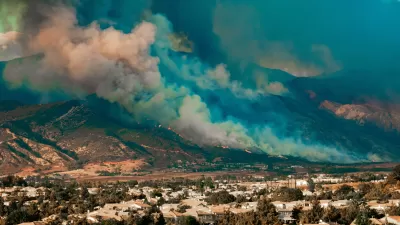New research says land use patterns have increased the costs of wildfire protection, so strategic land use planning would help lower the costs of wildfire protection.
"Building houses far apart and in locales beyond town -- the wildland-urban interface -- increases firefighting costs in the Rocky Mountain West, according to a new report from the Open Spaces Initiative at the University of Wyoming."
The news comes via the University of Wyoming website, which also notes that the study's authors argue for strategic land-use planning to "reduce wildfire suppression costs by increasing firefighting efficiency." Moreover, the "dramatic rise in firefighting costs over the last decade is due, in part, to the growth of residential development in the wildland-urban interface"—otherwise known as poor land use planning.
The efficiency of firefighting efforts falls precipitously as homes get farther apart in wildland areas. According to the study. "Using data from 291 wildfires in Colorado, Montana and Wyoming from 2002-2011, researchers found a single isolated home can add $225,000 to overall firefighting costs, while a home within a dense cluster can contribute as little as $100."
Hat tip to Shane Phillips for sharing the post.
FULL STORY: New Report Suggests Strategic Land-Use Planning Can Increase Firefighting Efficiency

Study: Maui’s Plan to Convert Vacation Rentals to Long-Term Housing Could Cause Nearly $1 Billion Economic Loss
The plan would reduce visitor accommodation by 25,% resulting in 1,900 jobs lost.

North Texas Transit Leaders Tout Benefits of TOD for Growing Region
At a summit focused on transit-oriented development, policymakers discussed how North Texas’ expanded light rail system can serve as a tool for economic growth.

Why Should We Subsidize Public Transportation?
Many public transit agencies face financial stress due to rising costs, declining fare revenue, and declining subsidies. Transit advocates must provide a strong business case for increasing public transit funding.

How to Make US Trains Faster
Changes to boarding platforms and a switch to electric trains could improve U.S. passenger rail service without the added cost of high-speed rail.

Columbia’s Revitalized ‘Loop’ Is a Hub for Local Entrepreneurs
A focus on small businesses is helping a commercial corridor in Columbia, Missouri thrive.

Invasive Insect Threatens Minnesota’s Ash Forests
The Emerald Ash Borer is a rapidly spreading invasive pest threatening Minnesota’s ash trees, and homeowners are encouraged to plant diverse replacement species, avoid moving ash firewood, and monitor for signs of infestation.
Urban Design for Planners 1: Software Tools
This six-course series explores essential urban design concepts using open source software and equips planners with the tools they need to participate fully in the urban design process.
Planning for Universal Design
Learn the tools for implementing Universal Design in planning regulations.
City of Santa Clarita
Ascent Environmental
Institute for Housing and Urban Development Studies (IHS)
City of Grandview
Harvard GSD Executive Education
Toledo-Lucas County Plan Commissions
Salt Lake City
NYU Wagner Graduate School of Public Service





























